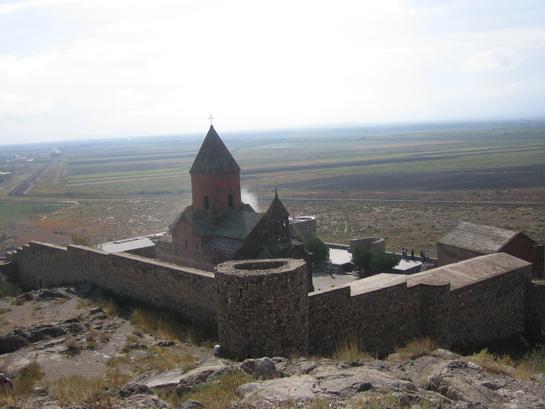PHOTOGRAPHY:
Khor Virap Monastery
XVI Century AD - Lusarvat Village, Ararat Marz
Khor Virap is one of the most popular destinations in Armenia for a number of reasons, primarily because it is where Grigor Luisavorich (St. Gregory the Illuminator) was imprisoned for 13 years before curing King Trdat III of a disease. This caused the conversion of the king and Armenia into the first officially Christian nation in the world in the year 301. To this day you can visit the underground chamber he was imprisoned, located in the nondescript St. Gevorg Chapel apart from the main church. Be careful in this building, there are two holes which can be climbed down but are unmarked. There is one smaller chamber by the door which has some stairs and then a twist and a ladder leading to the small room. There is another hole in the main room, to the right of the altar, with a long ladder leading down into the larger cistern where Grigor Luisavorich was imprisoned. It is actually impressive in size for an underground prison cell, and due to candles and a lack of air circulation was very stuffy, much like the other smaller chamber. Even with the candles it is rather useful to have a flashlight. I blew out all of the candles to preserve some oxygen when I went down there.
This monastery rests atop a little hill in an otherwise very flat Ararat Valley. You can make it out from the highway a few kilometers away and it grows bigger as you turn off the highway and drive towards it. When you arrive you will be as close to Mt. Ararat as you can probably get in Armenia. It is huge and towers over Khor Virap on even hazy days. You can actually see the green belt along the Arax River which denotes the boundary with Turkey from the monastery and there are some military lookout posts around this area. At night there are lights visible on Mt. Ararat, these are American listening posts and Turkish bases.
The large St. Astvatsatsin church at Khor Virap was built in the 17th century and is typical in design, but with a lack of virtually any decorative carving, or elements. It is located in a fort like complex with a nice courtyard. For most Armenians this is a very important site, and is easily accessible from Yerevan for a half day trip, or even better as a stop along the way to Southern Armenia or Karabakh.
On weekends you will often see weddings, performances, snack stands, and doves being sold for release. In the summer it can be very hot here, so morning might be the best time to come. The gates are locked at night time as early as 5:30pm.
On weekends you will often see weddings, performances, snack stands, and doves being sold for release. In the summer it can be very hot here, so morning might be the best time to come. The gates are locked at night time as early as 5:30pm.
The hill of Khor Virap and those adjoining were the site of the important early Armenian capital of ancient Artashat or Artaxiasata, built by King Artashes I, founder of the Artashesid dynasty, around 180 BC. According to legend, the Carthaginian general Hannibal, who spent his twilight years in flight from a vengeful Rome, inspired the founding of the city. There are extensive excavations of residential and other structures. Well-preserved mud-brick fortifications line the N slope of the third hill from the NE. Ancient coins and potsherds can still be found. The site was destroyed by the Persian King of Kings Shapur II, and the capital was moved to Dvin by King Khosrov III (330-338). The course of the rivers has evidently changed, since ancient authors said that this spacious and well-laid-out city was located at the confluence of the Araxes and Metsamor rivers. [This last paragraph is from the Rediscover Armenia Guidebook.]
Source: www.armeniapedia.org












No comments:
Post a Comment